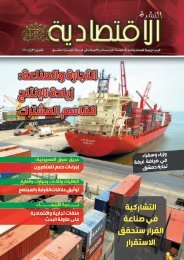SIGAR
2017-01-30qr
2017-01-30qr
You also want an ePaper? Increase the reach of your titles
YUMPU automatically turns print PDFs into web optimized ePapers that Google loves.
SECURITY<br />
TABLE 3.6<br />
DISTRICT CONTROL WITHIN THE 34 AFGHANISTAN PROVINCES<br />
AS OF NOVEMBER 26, 2016<br />
Control Status Districts Population Area<br />
Number % In millions % Sq Km %<br />
GIROA 20.4 63.6% 367,638 57.1%<br />
Control 83 20.4%<br />
Influence 150 36.9%<br />
CONTESTED 133 32.7% 9.2 28.7% 172,088 26.7%<br />
INSURGENT 2.5 7.8% 104,063 16.2%<br />
Control 9 2.2%<br />
Influence 32 7.9%<br />
Total 407 100% 32.1 100% 643,789 100%<br />
Note: GIROA = Government of the Islamic Republic of Afghanistan, sq km = square kilometers.<br />
Source: USFOR-A, response to <strong>SIGAR</strong> data call, 11/26/2016.<br />
contested districts rose 4.2% over the same period to 32.7% of all districts. 137<br />
Previously USFOR-A has described contested districts as having “negligible<br />
meaningful impact from insurgents,” contending that neither the insurgency<br />
nor the Afghan government maintains significant control over these areas. 138<br />
USFOR-A identified the regions/provinces with the largest percentage of<br />
insurgent-controlled or -influenced districts as Uruzgan Province, with five<br />
out of six (83.3%) of its districts under insurgent control or influence, and<br />
Helmand with eight out of 14 (57.1%) of its districts under insurgent control<br />
or influence. 139 The region with the most districts under insurgent control<br />
or influence is centered on northeast Helmand Province and northwestern<br />
Kandahar Province, and includes the Helmand/Kandahar border area,<br />
Uruzgan Province, and northwestern Zabul. This region alone accounts<br />
for 16 of the 41 districts (or 31.7%) under insurgent control or influence. 140<br />
The NATO-led Resolute Support (RS) mission determines district status by<br />
assessing five indicators of stability: governance, security, infrastructure,<br />
economy, and communications. 141<br />
USFOR-A attributes the loss of government control or influence over<br />
territory to the ANDSF’s strategic approach to security prioritization, identifying<br />
the most important areas that the ANDSF must hold to prevent defeat,<br />
and focusing less on areas with less strategic importance. 142<br />
Under its new Sustainable Security Strategy, the ANDSF targets “disrupt”<br />
districts for clearance operations when the opportunity arises, but will give<br />
first priority to protecting “hold” and “fight” districts under its control. 143<br />
USFOR-A determined that from August to November 2016, all the districts that<br />
moved under insurgent control or influence were located in “disrupt” areas<br />
and that the ANDSF actually increased the Afghan government’s influence<br />
over the population in districts prioritized as “fight” and “hold” areas. 144<br />
USFOR-A noted that the insurgents failed in their eight attempts to capture<br />
a provincial capital this year. 145 Although the insurgents gained some ground,<br />
90<br />
SPECIAL INSPECTOR GENERAL I AFGHANISTAN RECONSTRUCTION







